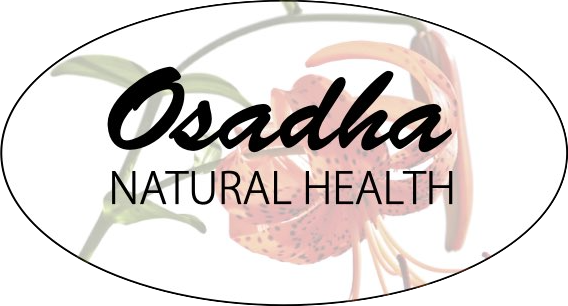All photos (c) 2017 Anna Marija Helt
Did you know that mushrooms are more closely related to animals than to plants? And that what we generally refer to as a “mushroom” are really just the sex parts, called fruiting bodies? We don’t usually see the whole organism, which lives buried in the soil, wood, or manure that is it’s host. In fact, lying largely unseen under the soil in Oregon is what is though to be the largest living organism in the world, a clonal colony of Honey Mushroom (Armillaria solidipes) that’s nearly 4 square miles in size. It does send up very visible fruiting bodies, and the mycelial mass can be found growing up the inside of the bark of the trees with which it has a parasitic relationship.
Fruiting bodies that consist of a stalk and cap used to be referred to as “toadstools”, a name that comes from Middle English. In some usages, “toadstool” specifically referred to poisonous species, possibly because toads themselves used to be regarded as highly poisonous. 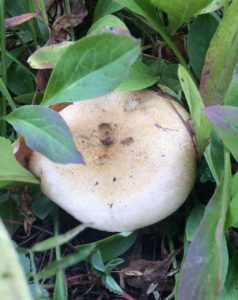
All of the species discussed here, both toadstool and not, are fairly easy to identify if you know what to look for. However, it’s a good idea to have a collection of identification books as well as some time spent with someone who knows the local mushrooms before heading out and gathering. Wherever you mushroom hunt, know with absolute certainty the identification of the fungus you are seeking and know the deadly and other seriously toxic species.
Mushroom Medicine Making
First, let’s get into how to use mushrooms for health. My preferred way is to eat those that are tasty. But, not all mushrooms that are useful as medicine necessarily taste pleasant. A traditional way to make mushroom medicine is to decoct them for several to many hours. This is a great way to extract the multi-functional beta-glucans and other helpful mushroom polysaccharides. The problem, however, is that mushrooms have other beneficial components that don’t dissolve so well in water, including terpenoids, polyphenols, nucleic acids, sterols and other compounds. So my favorite way to handle mushrooms, aside from eating them, is to make a combined tincture and decoction to capture as many constituents as possible in an easy to take form. This is called a “double extract”.
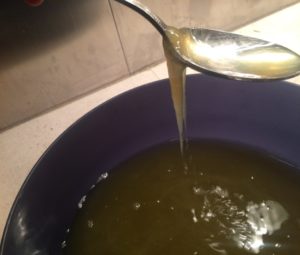 You don’t need fancy equipment to make a good double extract. The way I learned is from the California School of Herbal Studies (located in a mushroom mecca). First, the mushrooms are tinctured. I generally use about 60-70% ethanol for this, depending on the mushroom. After pressing out the tincture, the marc or a new batch of mushrooms if you have enough, is decocted. Usually I decoct for 2 or more hours, adding back more water as needed to keep it from burning or drying out, but the goal is to essentially make a reduction. The tincture and water extracts are then combined. If the concentration of ethanol is much over 25%, mushroom polysaccharides will start to precipitate out of solution. I don’t worry about this and just shake the double extract before dispensing.
You don’t need fancy equipment to make a good double extract. The way I learned is from the California School of Herbal Studies (located in a mushroom mecca). First, the mushrooms are tinctured. I generally use about 60-70% ethanol for this, depending on the mushroom. After pressing out the tincture, the marc or a new batch of mushrooms if you have enough, is decocted. Usually I decoct for 2 or more hours, adding back more water as needed to keep it from burning or drying out, but the goal is to essentially make a reduction. The tincture and water extracts are then combined. If the concentration of ethanol is much over 25%, mushroom polysaccharides will start to precipitate out of solution. I don’t worry about this and just shake the double extract before dispensing.
Others prefer the reverse process…to first decoct the mushroom then tincture second. This requires storing the decoction for at least two weeks while the tincture is macerating. I’ve tried both ways and prefer the way I initially learned (tincture first, decoct second). I haven’t seen much of a difference in the final product. Though if I have a lot of mushrooms, I will use a new batch, perhaps together with the marc, for the decoction.
And now for a selection of mushrooms I’ll be talking about at the conference, and including in a book on the medicinal and food uses of our local mushrooms (not that there’s a need for yet another book…). The bit of information on identification I provide in this article is not sufficient to go on. Get a few good identification books; at least one with a detailed key, one with good photos and one that is local (as opposed to relying solely on a North American field guide).
Agaricus spp – Meadow Mushroom and Horse Mushroom
If you think you don’t know this mushroom, think again! Agaricus bisporus is the ubiquitous white Button Mushroom common on pizzas and in grocery stores across the country. Incidentally, Button Mushrooms are the same species as both Crimini and Portabello mushrooms. Portabellos are simply the grown up version and Crimini, a color variant. We have several Agaricus species in Colorado (for a handy local guidebook with good photos, see Vera Stucky Evenson’s “Mushrooms of Colorado and the Southern Rocky Mountains” (1). I like this book together with “Mushrooms Demystified” by David Arora (2) for identification purposes. 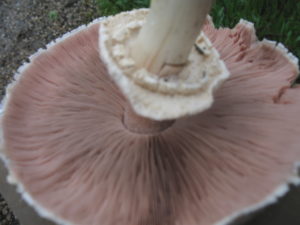
Of our local Agaricus species, Meadow Mushroom (A. campestris) and Horse Mushroom (A. arvensis) are delicious and have known medicinal uses. These species are eaten in many parts of the globe, from Mesoamerica to the Himalayas to East Africa (3-6), and can be used similarly as Button Mushrooms in terms of recipes….pizza topping, pasta dishes, gravy, as topping for steak. Though, when served salads that have raw mushrooms, pick them out. Mushrooms are best eaten cooked. One, raw mushrooms are hard to digest. Two, the Agaricus genus contains agaritine and other phenylhydrazine derivatives that may pose health problems. The research is confusing as to what extent they are problematic. Nevertheless, agaritine content is reduced somewhat by cooking, and perhaps more so by storing your shrooms in the fridge for 4 or more days before using. Robert Rogers provides a good summary on the agaritine controversy in his excellent book “The Fungal Pharmacy” (7). A good way to store mushrooms in the fridge is to put them in a bowl and cover with a wet paper towels.
Meadow and Horse Mushrooms show up on lawns, golf courses, pastures and meadows. Both have a mild odor with the latter having a faint, almond-like scent, and fruit from spring through fall. There are similar looking Agaricus species referred to as the “lose your lunch bunch” and at least one of these grows here. A way to distinguish it is to smell it…if the Agaricus mushroom has an stringent, unpleasant scent and stains bright yellow upon cutting, don’t collect it. It’s not deadly if you eat it, but you’ll feel like s—t for a while.
Agaricus mushrooms in general are distinguished by a white stalk and cap with an annular ring around the stalk. For mushroom folks, this general description is setting off warning bells right now, because it also fits for the deadly Destroying Angel Mushrooms (Amanita virosa, A. bisporigera, A. verna and A. ocreata) which also have white fruiting bodies with a ring around the stalk (if it hasn’t worn off). How to avoid making a deadly mistake? The Amanitas have white gills, a white spore print and a distinctive cup-like structure (the “vulva”) at the base. The vulva may be underground, so it’s important when harvesting Agaricus to dig down and make sure there is no volva. Agaricus have purplish to brown gills and a brown spore print. Destroying Angels have not been noted in Colorado to my knowledge, but the poisonous Amanita pantherina is and it can also be confused with Agaricus by someone not being careful.
Medicinally speaking, both Meadow and Horse Mushrooms have activity against antibiotic-resistant strains of bacteria like E. coli, Klebsiella and Pseudomonas, at least in petri dishes (8-10) which may or may not be relevant to a real infection in a person. Nevertheless, this is hopeful in this age of failing antibiotic efficacy and such bacterial species are often the bane of immunocompromised folks and those in long term health care situations. Also, Meadow Mushroom extracts reduced biofilm formation of the troublesome bacteria, Pseudomonas (11). Biofilms are structures secreted by bacteria that make them hard to kill and are often a problem in hospital settings.
Both Agaricus species also possess a collection of antioxidant constituents including tocopherols, glutathione and polyphenols (5, 11-14). Oxidative stress is involved in the aging process and also is a contributing factor to the major chronic diseases: Cancer, cardiovascular disease, diabetes, autoimmunity, arthritis. Moreover, both species kill tumor cell lines in cell culture models (15, 16). While killing cells in a dish doesn’t necessarily translate to efficacy against cancer in a person, it is an indicator of possibility! Speaking as someone who’s killed many a cancer cell in a dish…
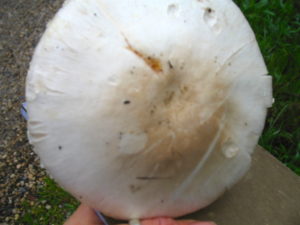 I’ve seen a number of writings naming Meadow Mushroom as a traditional treatment for diabetes, but so far can’t find the specific ethnobotanical information that actually describes where this was done. Here in North America? Europe? South America? Asia? All over? I will keep searching unless one of you knows and is kind enough to share the info! In any event, extracts of Meadow Mushroom did reduce blood sugar levels by inducing secretion of insulin and possibly by possessing some insulin-like activity or potentiating insulin activity in a rodent model of diabetes (17). (I know…I’m not a fan of animal studies either.)
I’ve seen a number of writings naming Meadow Mushroom as a traditional treatment for diabetes, but so far can’t find the specific ethnobotanical information that actually describes where this was done. Here in North America? Europe? South America? Asia? All over? I will keep searching unless one of you knows and is kind enough to share the info! In any event, extracts of Meadow Mushroom did reduce blood sugar levels by inducing secretion of insulin and possibly by possessing some insulin-like activity or potentiating insulin activity in a rodent model of diabetes (17). (I know…I’m not a fan of animal studies either.)
In terms of interesting chemistry, Horse Mushroom is particularly rich in glutamic acid (18). Glutamic acid converts into glutamate, a neurotransmitter involved in learning and memory. On a side note, glutamic acid tastes good and the flavor description “umani” was originated based on the taste of glutamic acid crystals isolated from seaweed. Horse Mushroom also contains a respectable amount of linoleic acid (18), an essential omega 6 fatty acid that is a component of cell membranes.
Amanita muscaria (Fly Agaric)
Fly Agaric is one of the best recognized and most beautiful mushrooms encountered in the woods, with it’s distinctive white-spotted red cap. It has traditionally been used as an entheogen for shamanic rituals In northern Europe and parts of Asia. 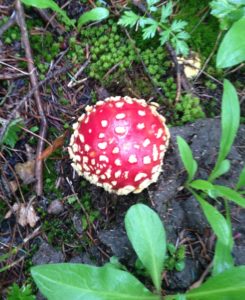
Fly Agaric are sometimes mistakenly put into the same category as Death Caps and Destroying Angels when it comes to toxicity. These Amanitas destroy the liver due to their content of alpha-amanitin and other amatoxins. Fly Agaric does not contain these toxins and doesn’t destroy the liver. However, Fly Agaric does contain neurotoxins; specifically ibotenic acid and muscimol, the aforementioned water-soluble components responsible for the toxic and entheogenic effects. The more potent muscarine is often cited as the poisonous component of Fly Agaric, but it is present only in minute quantities.
In Lithuania, where my mother’s family is from, Amanita muscaria are called “musmire grybai” for “the fly died mushroom” because the mushrooms were set out in milk to trap and kill flies. The flies were thought to be stupified by the mushroom then drown in the milk. Note that in researching for their review paper, Rubel and Arora found no solid reports of human deaths in North America from ingestion of Fly Agaric despite the fact that folks do harvest it for it’s potential psychoactive properties. (I don’t know how the North American Fly Agaric compares for entheogenic purposes with those growing in Siberia and other regions where they’ve traditionally been used.) They and others note one murky report where a fellow (a count, actually!) in 1897 ingested about two dozen mushrooms that he bought at a market. Were they actually Fly Agaric? Don’t know. Apparently what he actually died from remains unclear. For further geeking out on this, check out the Rubel and Arora paper (19).
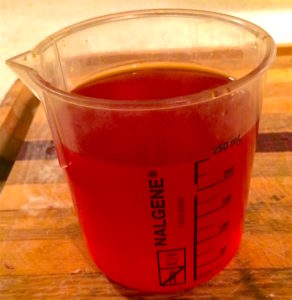 While not the most commonly used botanical in herbal practice nowadays, some herbalists in the US and Europe do use Fly Agaric. For example, in his book “The Fungal Pharmacy” Robert Rogers mentions a the traditional Finnish practice of steeping the red cap skins in vodka as a topical treatment for painful bruises (7). I’ve made such a tincture — it’s a beautiful ruby red — and have been using it on my painful overused joints, starting with just a few drops and working my way up dosage-wise. At this point, I use about 10 drops topically and it works. So far, no neurological reactions that I’ve noticed have cropped up though I’ve seen comments here and there that some folks may have reactivity even to topical use. I’ve also used it topically for sciatic pain and post-viral neuralgia in clients and it’s helped. Fly Agaric is also mentioned by Felter in his Eclectic Materia Medica, with respect to using minute doses of weak tincture internally for excess sweating, profuse urination, twitching, tremors and restlessness (20). Though he refers to muscarine as the main toxic principle, we know now that this is not the case.
While not the most commonly used botanical in herbal practice nowadays, some herbalists in the US and Europe do use Fly Agaric. For example, in his book “The Fungal Pharmacy” Robert Rogers mentions a the traditional Finnish practice of steeping the red cap skins in vodka as a topical treatment for painful bruises (7). I’ve made such a tincture — it’s a beautiful ruby red — and have been using it on my painful overused joints, starting with just a few drops and working my way up dosage-wise. At this point, I use about 10 drops topically and it works. So far, no neurological reactions that I’ve noticed have cropped up though I’ve seen comments here and there that some folks may have reactivity even to topical use. I’ve also used it topically for sciatic pain and post-viral neuralgia in clients and it’s helped. Fly Agaric is also mentioned by Felter in his Eclectic Materia Medica, with respect to using minute doses of weak tincture internally for excess sweating, profuse urination, twitching, tremors and restlessness (20). Though he refers to muscarine as the main toxic principle, we know now that this is not the case.
Boletus edulis – King Bolete
King Boletes rock! They’re a valued wild food in many parts of the northern hemisphere and were relied on (along with Horse Mushrooms and Chanterelles) as survival food during the food shortages of the Bosnian War in the 90’s (21). The Pomo culture who lived along and around the north central California coast prepared their Boletes on hot stones (22). In Italy they are known as “porcini”, meaning “little pigs”, due to their substantial plumpness. Incidentally, in Italy porcini were thought to fruit best during the new moon. I owe my current hunting spot for King Boletes to the owner of our local Italian bistro, Guido’s, who graciously shared with me the general area she and her family like to go. King Boletes are one of my (and many other folks’) favorite edible mushrooms, and they can be huge! There is, however, a bit of competition with the wriggly maggots you may find in some of the big shrooms…if that doesn’t bother you, you can just cut around them.
The “edulis” part of Boletus edulis means “edible”, and, wow is it ever. A good way to 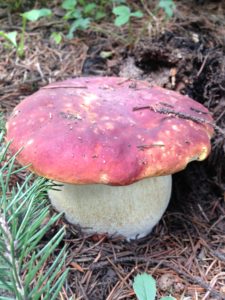 bring out the flavor of Boletes is to dry sautee them before use. But first, use a brush or paper towel to wipe them off. Try to avoid using water to clean them; Boletes are like sponges. If the spore releasing surface under the cap is whitish and firm, it can be retained. If spongy and yellow or greenish, peel it off. Some folks also peel the surface skin from the cap but this isn’t necessary. Cut cap and stalk into uniform, thin slices and place in single layer on a pan preheated on medium heat on the stove. Sprinkle with salt. The purpose of dry sauteing the mushrooms like this is to remove water while preventing the mushrooms from steaming each other and turning rubbery if cooked in pile. Dry sauteeing improves flavor as well. As the mushrooms just start to brown, either scrape them to the side of the pan or scoop them onto a plate and set aside. Repeat the process with another layer of mushrooms. Once all have been through the process, you can now pile the mushrooms up and add butter or your preferred cooking oil. I also add finely diced shallots and garlic along with black pepper, and use vodka, vermouth, white wine or sherry to deglaze the pan.
bring out the flavor of Boletes is to dry sautee them before use. But first, use a brush or paper towel to wipe them off. Try to avoid using water to clean them; Boletes are like sponges. If the spore releasing surface under the cap is whitish and firm, it can be retained. If spongy and yellow or greenish, peel it off. Some folks also peel the surface skin from the cap but this isn’t necessary. Cut cap and stalk into uniform, thin slices and place in single layer on a pan preheated on medium heat on the stove. Sprinkle with salt. The purpose of dry sauteing the mushrooms like this is to remove water while preventing the mushrooms from steaming each other and turning rubbery if cooked in pile. Dry sauteeing improves flavor as well. As the mushrooms just start to brown, either scrape them to the side of the pan or scoop them onto a plate and set aside. Repeat the process with another layer of mushrooms. Once all have been through the process, you can now pile the mushrooms up and add butter or your preferred cooking oil. I also add finely diced shallots and garlic along with black pepper, and use vodka, vermouth, white wine or sherry to deglaze the pan.
King Boletes are widespread in colorado and many folks that I know in Durango head out annually to gather them. They (the Boletes and their hunters!) are easy to spot once you know what to look for. King Boletes have a mycorrhizal relationship with Spruce, Pines and other trees around here and the fruiting bodies pop up from the ground from the upper foothills to just below tree line, mid-July to September. Some years they pop up earlier, some later. I have the best luck finding them at around 10,000 feet elevation. The fruiting bodies are most often found among the trees at the edges of clearings, along trails, etc. The caps can be up to 20 cm across and are a rusty reddish-brown, sometimes fading to yellow/orangish in the sun. The stalk is thick, bulbous and white to pale yellow. The surface has a light colored vein-like network, especially right under the cap. This is a polypore mushroom, meaning that the spores are produced and shed through tiny holes on the underside of the cap rather than from gills. The pore surface is white in young fruiting bodies, turning spongy and yellowish to olive green as they age.
Fly Agaric is used as an indicator species for finding King Boletes, since they grown in the same terrain. I usually see one or the other in a given season at a given spot. Meaning that one year I may find a lot of Fly Agarics in a particular spot but not many Boletes. The next year in the same spot, the Boletes have seemingly taken over with nary a Fly Agaric to be seen. Is this due to rainfall? Temperature? Planetary Position? Who knows.
A look-alike, the Aspen Bolete, also grows here in the Southern Rockies and is edible. I don’t think it tastes so great and it may cause gastrointestinal distress in some folks. As the name implies, Aspen Boletes grow in Aspen groves. They are of similar size, maybe a bit smaller than King Boletes in terms of the cap, and the stalk is not quite so chubby. The delicate web-like network on the stalk surface is dark rather than the white-to pinkish color found on King Boletes.
The antioxidant activity of Boletes has been studied more than perhaps anything else medicinally-related and is due to multiple mushroom constituents, including polysaccharides along with polyphenols such as gallic acid, caffeic acid, quercetin and beta-carotene (23-26 and many others). I mentioned the significance of oxidative stress earlier. Of those studied, King Boletes seem to be one of the strongest anti-oxidant mushrooms.
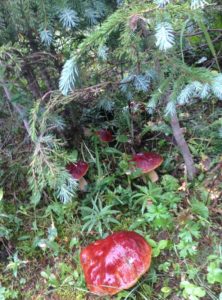 Boletes show some activity against Herpes Simplex Virus (HSV1) as well as Candida and both gram positive and gram negative strains of bacteria, at least in a dish (25, 27, 28). That these experiments were done in a dish implies direct inhibitory activity by the mushroom extracts, as opposed to immune system activation. Though Bolete polysaccharides and lectins do stimulate white blood cell production (29, 30), suggesting that Boletes have multiple ways of inhibiting microbial infections.
Boletes show some activity against Herpes Simplex Virus (HSV1) as well as Candida and both gram positive and gram negative strains of bacteria, at least in a dish (25, 27, 28). That these experiments were done in a dish implies direct inhibitory activity by the mushroom extracts, as opposed to immune system activation. Though Bolete polysaccharides and lectins do stimulate white blood cell production (29, 30), suggesting that Boletes have multiple ways of inhibiting microbial infections.
As with a number of other mushrooms, King Boletes inhibit tumor cell proliferation, both in cell culture as well as in rodent models (31-35). In fact, a terpene dubbed “boledulin A” was isolated from mycelial culture and found to have higher tumor cell toxicity in cell culture than the commonly used chemotherapeutic drug, Cisplatin (35). In the other studies, polysaccharide and glycoprotein water extracts were active against tumor cells, as well as a fraction that consisted of over 50% mushroom RNA (31-34).
Boletes may also provide respiratory and cardiovascular system support via anti-inflammatory effects (36, 37) and may additionally support the heart and blood vessels by influencing blood lipid balance (38).
Because this is one of my favorite edibles, it was a bit sad setting some Boletes aside for extract making. Though the double extract turned out to be one of the slimiest I’ve ever made. Lots of polysaccharides!
Calvatia, Lycoperdon & other spp – Puffballs
Puffballs look like their name implies. I guess means that they are not, in fact, toadstools since they lack a stalk. Plus, their roundness may make them more difficult for perching upon. We have at least seven Puffball species in the Southern Rockies: Giant Western Puffball (Calvatia booniana), Smokey Puffball (Calvatia fumosa), Tumbling Puffball (Bovista plumbea), Sculptured Puffball (Calbovista subsculpta), Gem-Studded Puffball 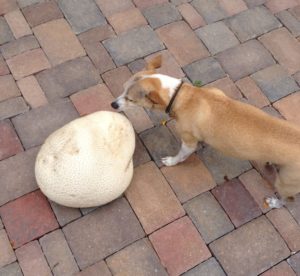 (Lycoperdon perlatum), Pear-Shaped Puffball (Lycoperdon pyriforme) and Purple-Spored Puffball (Calvatia cyathiformis, aka C. fragilis, C. lilicina or Bovista lilicina and a whole host of other names…Geez!) (1, 2). A fun assortment of names, to be sure, but my favorite by far is “Old Man’s Fart”, reflecting the dark cloud of spores that explodes out when you step on a ripe puffball (39). In any event, fruiting body size ranges wildly from marble to gobstopper to grapefruit to soccer ball depending on the species and fruiting body age.
(Lycoperdon perlatum), Pear-Shaped Puffball (Lycoperdon pyriforme) and Purple-Spored Puffball (Calvatia cyathiformis, aka C. fragilis, C. lilicina or Bovista lilicina and a whole host of other names…Geez!) (1, 2). A fun assortment of names, to be sure, but my favorite by far is “Old Man’s Fart”, reflecting the dark cloud of spores that explodes out when you step on a ripe puffball (39). In any event, fruiting body size ranges wildly from marble to gobstopper to grapefruit to soccer ball depending on the species and fruiting body age.
Puffballs have traditional medicinal (and food) uses across North America. Many of the uses were topical treatments for mastitis, sores, abscesses, injuries, bleeding and for healing the belly button in newborns. For nosebleeds specifically, a chunk of fruiting body was stuffed into the offending nostril(s) while for bleeding wounds the spores were often used (39-42). The use of Puffballs as food, styptic and wound treatment is found across the globe: Mezoamerica, South America, China, Japan, Nepal, Europe, India (40, 43-47). Ceramics from Peruvian cultures that date back to 800 BCE show what may be representations of Puffballs, and some species are still eaten today in parts of Peru (44).
Multiple Puffball species have been researched scientifically at least to some extent, and exhibit a whole slew of “anti-“ effects: Anti-tumor (in cell culture and rodent studies), anti-parasitic, anti-fungal, anti-bacterial and anti-oxidant (48).
Of our local crew, Purple-Spored Puffball has been fairly well studied. It is a cosmopolitan Puffball, and you have to wonder just how much of an effect where it grows has on it’s medicinal properties. (The same can be said of other mushrooms and herbs). Protein extracts from the fruiting bodies inhibit the proliferation of cancer cells but not “normal” cells in culture lines in cell culture experiments (49-51). This differential activity will be interesting if it works in actual people. “Normal” is in quotes because once you stick a cell in a plastic dish, the cell is no longer “normal”. Fractions active against bacteria and fungi have been isolated from Purple-Spored Puffball and this and other Puffballs contain calvatic acid, which is active against Staph, E. coli, Salmonella, Klebsiella, Pseudomonas and other problematic species of bacteria (40, 48, 52). Traditionally speaking, Purple-Spored Puffball is also a cough and sore throat remedy in Taiwan, China and Japan and a treatment for leucorrhea and infertility in Nigeria (3, 46).
Of the other Rocky Mountain Puffballs, chemical isolates from Pear-Shaped Puffballs inhibit a parasitic roundworm that causes widespread crop loss throughout the world (53), while Tumbling Puffball water extracts possess both strong anti-oxidant effects as well as anti-bacterial activity (54, 55).
Mushrooms can be heavy metal accumulators, and Puffballs are especially adept at it. As with any wildcrafting, it’s important to do your best to gather Puffballs from a clean environment. Plucking them downstream from mines, which are common in the Rockies, probably isn’t the best approach.
Many Puffballs are edible but I think the best in our region is the Giant Western Puffball, which conveniently grow on my generous neighbor’s lawn. For a size reference see the photo comparison of Milo the Chiweenie versus Giant Puffball. Milo approached the Puffball with a trepidatious mix of “What the hell is that?” and “Can I eat it?”. Here is a tasty recipe for using this and other edible Puffballs…
———————-
Puffball-Stuffed Ravioli
First, make sure the puffball is pure white all through it upon slicing. The inside will start turning yellow/green as spores are produced. Also, for smaller puffballs, slice in half from top to bottom to make sure it’s not a baby Amanita, which can look very similar. The difference is that the Amanita will have an embryonic mushroom growing inside, the outline of which will be visible, though sometimes only faintly, while a not-yet-sporulating puffball will be solid white.
Filling
Peel or slice the outer skin off of the fruiting body. Cut into slices ~ a cm thick or less. Layer in single layer in pan preheated on medium heat, sprinkle with a bit of sea salt and dry sautee as described for Boletes. Add butter, a couple of chopped sage leaves and diced shallots and stir around until shallots become translucent. Grind in a food processor with a bit of fresh parsley, a teaspoon of grated Parmesan and/or Peccorino Romano per cup of cooked mushroom, salt, pepper and garlic powder to taste. Mix at desired ratio with ricotta cheese (I like about 2/3 mushroom blend + 1/3 ricotta).
Pasta
2 cups semolina flour
1 cup duram flour
3 large eggs
3 TBLSP water
1 tsp olive oil
1/2 tsp salt
Mix the 2 flours and make a “volcano” with the mix. Mix eggs, water and salt in measuring cup. Add this liquid mix slowly to center of volcano and mix with a finger until the liquid is incorporated. You won’t need all of the flour, so save or discard the dry portion. Make a dough ball and knead on a floured surface for 8-10 minutes. Roll into blob and wrap tightly in plastic wrap. Let it rest at room temperature for 30 minutes. Roll out and cut either for ravioli or tortellini, then stuff, then they’re ready to boil. As a sauce, I prefer something not too overpowering so as to not take focus away from the mushroom flavor; either drizzled with browned butter or a mellow white sauce with the addition of a small amount of the aforementioned vodka, vermouth, white wine or sherry. Though red sauces would also be great if that’s more to your taste! Another dressing I like is olive oil with sliced fresh, sweet heirloom tomatoes. This is making me hungry.
Sarcodon imbricatus (aka. S. aspratus) – Hawks Wing
Mushroom foragers in the Rockies are familiar with this distinctive-looking mushroom, with its large, scaly cap that can reach 10 inches in diameter. Instead of gills or a polypore surface, Hawks Wings have small tooth-like projections from which they release their spores. In Greek, Sarco means “flesh” while odon means “tooth”. 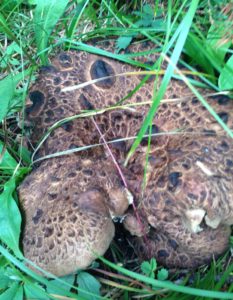
These are edible fungi — rich in trace elements like magnesium, zinc, manganese and iron — and eaten in many parts of the world. But, Hawks Wings that I’ve tried in Colorado taste like old shoes, or at least what I imagine old shoes would taste like. The smaller, younger fruiting bodies are supposed to taste better, and have less of a chance for causing digestive upset, but they just taste like smaller old shoes. The double extract doesn’t taste much better. It starts hopefully with a hint of sweetness followed abruptly by a strong, sharp, burned rubbery taste.
Despite the not-so-appealing flavor, Hawks Wings shine as medicine.
Both water- and alcohol-soluble Hawks Wing extracts possess anti-microbial activity against a wide variety of gram positive and gram negative bacteria, including some antibiotic resistant strains, in lab studies (10, 56, 57). Hopefully this will extend to efficacy in people, given that antibiotic resistance and difficult-to-treat infections are a growing problem. On a related note, alcohol-based extracts prevented bacterial biofilm formation (56).
On the viral side of things, a polysaccharide fraction derived from fruiting bodies was active against Herpes Simplex Virus (HSV1) in cell culture (57), but the concentration of extract used was pretty high, so I’m not sure how effective it would be in real life.
As with many mushrooms, Hawks Wings demonstrate anti-tumor activity in cell culture models, due at least in part to ergosterol derivatives (58-60). Ergosterol is a well known component of fungal cell membranes. Also in the tumor cell-inhibiting department, a water extract of the mushroom reduced the activity of telomerase in a tumor cell line (61). Telomerase is an enzyme that is important for the integrity of our chromosomes but is overactive in many forms of cancer. A water extract strongly inhibited tumor growth in a rodent model, and the polysaccharide component was thought to be the active principle (62).
Hawks Wing also acts as an immunomodulator, stimulating immune system activation by inducing white blood cell proliferation while reducing inflammation and influencing TH1 versus TH2 responses (58, 63-67). Moreover, the anti-inflammatory activity may be useful for inflammatory bowel conditions (66), which seems to be a relatively frequent health issue in my small herbal practice.
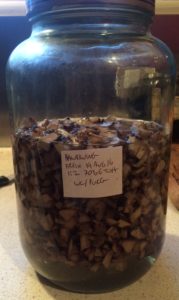 Hawks Wing’s benefits extend to the cardiovascular system, with water extracts having ACE inhibitor activity, which lowers blood pressure (68, 69). In China, the mushroom has been used for lowering cholesterol and for circulatory support (70). Keep in mind that a main trigger for elevated cholesterol is inflammation, so the anti-inflammatory properties of Hawks Wing may be relevant here as well.
Hawks Wing’s benefits extend to the cardiovascular system, with water extracts having ACE inhibitor activity, which lowers blood pressure (68, 69). In China, the mushroom has been used for lowering cholesterol and for circulatory support (70). Keep in mind that a main trigger for elevated cholesterol is inflammation, so the anti-inflammatory properties of Hawks Wing may be relevant here as well.
Also in China, Hawks Wing mushroom is used as a muscle relaxant (70). I’ve added it to my muscle and joint formula to give it a go….
Trametes versicolor (aka. Coriolus versicolor, Polyporus versicolor) – Turkey Tails
Turkey Tails have been used medicinally for centuries in North America, Europe and Asia for a variety of indications; everything from strengthening the body and spirit to improving the person’s defenses, removing wastes, dispelling heat, treating a distressed liver, and so on. For a great review on Turkey Tail history, folklore, and traditional and modern uses, visit Robert Roger’s chapter on Turkey Tails in “The Fungal Pharmacy” (7). 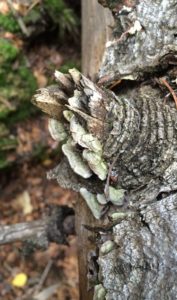
Turkey Tails grow in many places in North America, including here in Southwest Colorado. They were much easier to find in the Bay Area, where I was first introduced to them and where it is much wetter than here. In fact, Turkey Tails could be found devouring the wooden porch belonging to my first medicinal mushroom teachers.
Turkey Tails are a beautifully striped and colorful polypore mushroom that grow on dead wood…logs, stumps, etc. I’ve seen the fruiting body every color from brown to red, orange, blue and even green, though the green could possibly be from colonization by algae or other organisms. The polypore surface on the underside, where spores are released, is white when the fruiting bodies are young and yellowish as they age.
Turkey Tails can be used in a variety of ways…as a decoction, tincture, double extract or as commercially available encapsulated extracts. They make a good broth to use as a soup base, but the fruiting bodies are tough and chewy, so you might remove them before serving the soup. I like to use the fruiting bodies when I can find them, but when I can’t, I use organically cultured mycelia that are commercially available. There is evidence that many of the activities are similar between the fruiting body and the mycelia. This isn’t always the case for mushrooms.
This is one of the most frequently used mushrooms in my practice. Much has been written about Turkey Tails, given that this species is one of the best researched among the mushrooms. Most of the research is done on two specific fractions, polysaccharoprotein Kureha (PSK) and polysaccharopeptide (PSP) isolated from cultured mycelia. PSK in particular has been in use as adjunct therapy in cancer treatment for decades in Asia and both PSK and PSP improve quality of life and disease free survival time in clinical trials of a variety of cancers.
However, there are other components of the mushroom that are also “active principles”, and both fruiting bodies and cultured mycelia have shown similar anti-tumor properties. For instance, a constituent other than PSK and PSP that shows anti-tumor activity is“SPCV” (small polypeptide from Coriolus versicolor), a polypeptide that was more potent than either PSK or PSP in inhibiting the proliferation of leukemia cell lines in cell culture (71). Also, a protein dubbed “TVC” had been isolated and found to stimulate white blood cell production in the absence of PSK and PSP (72).
Because of this, and being an herbalist, I’m most interested in the use of (and what’s known about) crude extracts. I prefer Turkey Tails as a double extract to try to get a wide 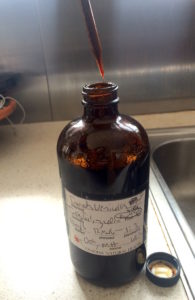 variety of it’s components in my preparations. I combine the double extract with an herb or two to support clients undergoing radiation treatment or certain forms of chemotherapy. And, some clients with a personal or familial history of cancer have been using Turkey Tails as a tonic.
variety of it’s components in my preparations. I combine the double extract with an herb or two to support clients undergoing radiation treatment or certain forms of chemotherapy. And, some clients with a personal or familial history of cancer have been using Turkey Tails as a tonic.
There are some studies out there on more crude preparations of Turkey Tails. In terms of cell culture experiments, ethanolic extracts of either mycelia or fruiting body reduced DNA damage in cells and showed anti-oxidant activity (73). Cultured mycelia were active against Influenza Virus (H1N1) and Herpes Simplex Virus (HSV2) in cell culture (74). Both crude water and alcohol extracts have been found to kill tumor cells in a dish while remaining nontoxic to “normal” cells, as well reducing tumor burden in animal models (75-78). Other rodent studies have demonstrated hepatoprotective, neuroprotecitve, immune boosting and beneficial blood lipid effects with crude preparations of the mushroom (79-83).
More relevant and appropriate are experiences in people. A study in HIV positive patients where they ingested 1.5-3 grams of mushroom daily resulted in increased white blood cell count and overall better energy (84). Granted it was a very tiny open label study, but who cares if the patients benefitted? A case cited by Standish, et al (85) involved a woman with stage II B cell lymphoma that had gone into remission following chemo, with subsequent recurrence in multiple locations based on scan results. The drug Rituxin combined with a commercial product called “Coriolus-MRL” consisting of both fruiting body and mycelial powder resulted in a resolution of the “hot spots”. However, it’s not possible to attribute the resolution to Rituxin, Turkey Tails or both in this case. Finally, a phase I clinical trial in female breast cancer patients who had recently completed radiation treatment was carried out with mycelium powder, and various immune system parameters improved in these immunocompromised women (86).
______________________________________________________________Some good mushroom websites: www.coloradomushrooms.com, http://botit.botany.wisc.edu/toms_fungi/, http://www.mushroomexpert.com/, and http://www.mykoweb.com/.
______________________________________________________________
~~~
Content © Dr. Anna Marija Helt, Osadha Natural Health, LLC. Permission to republish any of the articles or videos in full or in part online or in print must be granted by the author in writing.
The articles and videos on this website for educational purposes only & have not been evaluated by the Food and Drug Administration. This information is not intended to diagnose, treat, cure, or prevent any disease or to substitute for advice from a licensed healthcare provider.
References
- Stucky, V (1997) Mushrooms of Colorado and the Southern Rocky Mountains. Westcliffe Publishers.
- Arora, D (1986) Mushrooms Demystified. Ten Speed Press.
- El Enshasy, A, et al (2013) Mushrooms and Truffles: Historical Biofactories for Complementary Medicine in Africa and in the Middle East. Evidence-Based Complementary and Alternative Medicine. Article ID 62045.
- Alonso-Aguilar, LE, et al (2014) The cultural significance of wild mushrooms in San Mateo Huexoyucan, Tlaxcala, Mexico. J Ethnobiol Ethnomed. 10:27.
- Sharma, SK & N Gautam (2015) Chemical, bioactive and antioxidant potential of twenty wild culinary mushroom species. Biomed Res Internat. Article ID: 346508.
- Quiñónez-Martínez, M, et al (2014) Knowledge and use of edible mushrooms in municipalities of the Sierra Tarahumana, Chihuahua, Mexico. J. EThnobiol & (2016) Determination of cytotoxic, anticholinesterase, antioxidant and antimicrobial activities of some wild mushroom species. Highest in catecin (arvensis & campestris). Cogent Food & Agricult. 2:1170860
- Rogers, R (2011) The Fungal Pharmacy: The complete guide to mushrooms and lichens of North America. North Atlantic Books. Barros (2007) Antimicrobial activity and bioactive compounds of Portuguese wild edible mushrooms methanolic extracts. Euro Food Res and Tech. 225(2):151-6.
- Alves, MJ, et al (2013) Antimicrobial activity of phenolic compounds identified in wild mushrooms, SAR analysis and docking studies. J Appl Microbiol. 115:346-57.
- Giri, S, et al (2012) Antimicrobial activities of basidiocarps of wild edible mushrooms of West Bengal, India. Int J Pharm Tech Research. 4(4):1554-60.
- Alves, MJ, et al (2012) Antimicrobial activity of wild mushroom extracts against clinical isolates resistant to different antibiotics. J Applied Microbiol. 113(2):466-75. Food Funct. 2015 Jun;6(6):1900-10. doi: 10.1039/c4fo01135j.
- Glamo?lija, J, et al (2015) A comparative study on edible Agaricus mushrooms as functional foods. Food Funct. 6(6):1900-10.
- Dogan, H, et al (2016) Determination of Glutathione, Selenium, and Malondialdehyde in Different Edible Mushroom Species. Biol Trace Elem Res.174(2):459-463.
- Dundar, A, et al (2016) Determination of cytotoxic, anticholinesterase, antioxidant and antimicrobial activities of some wild mushroom species. Highest in catecin (arvensis & campestris). Cogent Food & Agricult. 2:1170860
- Bubeanu, C, et al (2015) Comparative analysis of polyphenolic profiles and antioxidant activity of Agaricus bisporus and Agaricus campestris. Scientific Bull. Series F. Biotech. 19: 29-33.
- Elbatrawy EN, et al (2015) Medicinal Mushroom Extracts Possess Differential Antioxidant Activity and Cytotoxicity to Cancer Cells. Int J Med Mushrooms. 2015;17(5):471-9.
- Zhao, JK, et al (2011) Isolation and characterization of a novel thermostable lectin from the wild edible mushroom Agaricus arvensis. J Basic Microbiol. 51(3):304-11.
- Gray, AM & PR Flatt (1997) Insulin-releasing and insulin-like activity of Agaricus campestris (mushroom). J Endocrin. 157(2):259-66.
- Ayaz, FA, et al (2011) Fatty acid and amino acid compositions of selected wild-edible mushrooms consumed in Turkey. Int J Food Sci Nutr. 2011 Jun;62(4):328-35.
- Rubel, W & D Arora (2008) A Study of Cultural Bias in Field Guide Determinations of Mushroom Edibility Using the Iconic Mushroom, Amanita muscaria, as an Example. Econ Botany. 62(3):223-43.
- Felter, HW (1922) The Eclectic Materia Medica, Pharmacology and Therapeutics. (Can find a copy of this published on Michael Moore’s website, www.SWSBM.com)
- Redzic, S (2010) Wild Mushrooms and Lichens used as Human Food for Survival in War Conditions; Podrinje – Zepa Region (Bosnia and Herzegovina, W. Balkan). Res Human Ecol. 17(2):175-187.
- Hector, S (2012) California Ethnobotany of Mushrooms: Eaten as Food. www.academia.edu.
- Vamanu, E & S Nita (2013) Antioxidant Capacity and the Correlation with Major Phenolic Compounds, Anthocyanin, and Tocopherol Content in Various Extracts from the Wild Edible Boletus edulis Mushroom. Biomed Res International. Article ID313905.
- Luo, A, et al (2012) Purification, characterization and antioxidant activities in vitro and in vivo of the polysaccharides from Boletus edulis Bull. Molecules. 17:8079-90.
- Kosanic, M, et al (2012) Mushrooms as possible antioxidant and antimicrobial agents. Iran J Pharm Res. 11(4):1095-1102.
- Robaszkiewicz, A, et al (2010) The role of polyphenols, beta-carotene and lycopene in the antioxidative action of the extracts of dried, edible mushrooms. J Nutr and Metab. Article ID 173274.
- Santayo, S, et al (2012) Antiviral activities of Boletus edulis, Pleurotus ostreatus and Lentinus edodes extracts and polysaccharide fractions against Herpes simplex virus 1. J Food Nutr Res. 51(4):225-35.
- Zavastin, DE, et al (2016) Studies on antioxidant, antihyperglycemic and antimicrobial effects of edible mushrooms Boletus edulis and Cantharellus cibarius. J Plant Dev. 23:87-95.
- Li, WG, et al (2013) Separation, purification and identification of acidic polysaccharide fraction extracted from Boletus edulis and its influence on mouse lymphocyte proliferation in vitro. J Chem Pharmaceut Res. 5(12):431-437.
- Zheng, S, et al (2007) A lectin with mitogenic activity from the edible mushroom Boletus edulus. Process Biochem. 42(12):1620-4.
- Lucas, EH, et al (1957) Tumor inhibitors in Boletus edulis and other holobasidiomycetes. Antibiot & Chemother. 7(1).
- Wang, D, et al (2014) Characterization of a water-soluble polysaccharide fromBoletus edulis and its antitumor and immunomodulatory activities on renal cancer in mice. Carbohydrate Polymers. 105(25):127-34.
- Lemieszek, MK et al (2013) Boletus edulis biologically active biopolymers induce cell cycle arrest in human colon adenocarcinoma cells. Food Funct. 4:575-585.
- Lemieszek, MK, et al (2016) Boletus edulis ribonucleic acid – a potent apoptosis inducer in human colon adenocarcinoma cells. Food Funct. 7:3163-3175.
- Feng, T, et al (2011) Non-isoprenoid botryane sesquiterpenoids from basidiomycete Boletus edulis and their cytotoxic activity. Nat Prod Bioprospect. 1(1):29-32.
- Wu, S, et al (2016) Anti-inflammatory effects of Boletus edulis polysaccharide on asthma pathology. Am J Transl Res. 8(10):4478-89.
- Grzybek, J, et al (1992) Evaluation of anti-inflammatory and vasoprotective actions of the polysaccharides isolated from fruit bodies of Boletus edulis. Planta Med. 58 (Suppl Issue 1):A641.
- Gil-Ramirez A, et al (2011) Proceedings of the 7th international conference on mushroom biology and mushroom products.
- Bannister, K (2006) Profit River Ethnobotany: A report on traditional plant knowledge and contemporary concerns of the Prophet River First Nation. http://www.bcogris.ca/documents/scek/Final_Reports/Prophet_River_Ethnobotany_April_2006_Final_Report.pdf
- Burk, WR (1983) Puffball usages among North American indians. J Ethnobiol. 3(1):55-62.
- Smith, HH (1932) Ethnobotany of the Ojibwe Indians. Bulletin of the public museum of the city of Milwaukee. 4(3):327-525.
- Craig, N. Native American use of edible mushrooms in the Southwest. The Arizona Mushroom Forum. http://arizona-mushrooms.org/2015/01/14/native-american-mushrooms-in-southwest/
- Negi, K, et al (2014) Most prominent ethno-medicinal plants used by tribals of Chhitkul, Sangla Valley. Ann Plant Sci. 4(1):943-6.
- P.Trutmann (2012) The Forgotten Mushrooms of Ancient Peru. Global Mountain Action, Fungi and Mountains Publication Series: No 1. 2012, pp 33.
- Martinez, GJ & Lujan MC (2011) Medicinal plants used for traditional veterinary in the Sierras de Córdoba (Argentina): An ethnobotanical comparison with human medicinal uses. J Ethnoliol Ethnomed. 7:23.
- Kawahara, N, et al (1995) Two steroids from Calvatia cyathiformis. Phytochem. 38(4):947-50.
- Shrestha, S & BR Kropp (2009) Use of Calvatia gigantea to treat pack animals in Nepal. Fungi – Special Issue – Ethnomycology. 2(2).
- Coetzee, JC & AE van Wyk (2009) The genus Calvatia (‘Gasteromycetes’, Lycoperdaceae): A review of its ethnomycology and biotechnological potential. Af J Biotech. 8(22):6007-15.
- Yeh, C-H, et al (2011) Calvatia lilacina protein extract induces apoptosis through endoplasmic reticulum stress in human colon carcinoma cells. Process Biochem. 46(8):1599-1606.
- Wu, J-Y, et al (2011) Anti-cancer effects of protein extrcts from Cavatia lilacina, Pleurotos ostreatus and Volvariella volvacea. Evid Based Comp & Alt Med. Article ID 982368.
- Tsay, J-G, et al (2009) abstr Calvatia lilacina Protein-Extract Induces Apoptosis through Glutathione Depletion in Human Colorectal Carcinoma Cells. J Agric Food Chem. 57(4):1579-88.
- Calvino, R, et al (1986) Chemical and biological studies on calvatic acid and its analogs. J antibiotics. 39(6): 864-868.
- Kopcke, B, et al (1998) Bioactive azo- and azoxyformamides from Lycoperdon pyriforme (Schaeff. Ex Pers.) Natural Product Letters. 13(1):41-6.
- Sadi, G (2016) Wild Edible Mushrooms from Turkey as Possible Anticancer Agents on HepG2 Cells Together with Their Antioxidant and Antimicrobial Properties. Int J Med Mush. 18(1):83-95.
- Wani, AH, et al (2010) Potential antioxidant activity of some mushrooms growing in Kashmir Valley. Mycopath. 8(2):71-75
- Alves, MJ, et al (2014) Wild mushroom extracts as inhibitors of bacterial biofilm formation. Pathogens. 3:667-79.
- Sulkowska-Ziaja, K, et al (2011) Isolation and biological activities of polysaccharide fractions from mycelium of Sarcodon imbracatus L.P. Karst (Basidiomycota) cultured in vitro. (2011) Acta Poloniae Pharmaceutics – Drug Research. 68(1):143-4.
- Kobori, M, et al (2007) Ergosterol peroxide from an edible mushroom suppresses inflammatory responses in RAW264.7macroph ages and growth of HT29 colonadenocarcinoma cells. British J Pharmacol. 150:209-19.
- Takei, T, et al (2005) Ergosterol peroxide, an apoptosis-inducing component isolated from Sarcodon aspratus (Berk.) S. Ito. Biosci Biotechnol Biochem. 69(1):212-15.
- Han, J, et al (2014) Upregulation of death receptor 5 and activation of caspase 8/3 play a critical role in ergosterol peroxide induced apoptosis in DU145 cancer cells. Cancer Cell International. 14:117.
- Xu, B, et al (2014) Telomerase inhibitory effects of medicinal mushrooms and lichens, and their anticancer activity. Int J Med Mushrooms. 16(1):17-28.
- Maruyama, H, et al (1989) Antitumor activity of Sarcodon aspratus (Berk.) S. Ito and Ganoderma lucidum (Fr.) Karst. J. Pharmacobiodyn. 12(2):118-23.
- Han, XQ, et al (2010) Structural elucidation and immunological activity of a novel polysaccharide from the fruit bodies of an edible mushroom, Sarcodon aspratus (Berk.) S. Ito. Int. J. Biol Macromol. 47(3):420-4.
- Mizuno, M, et al (2000) Fucogalactan isolated from Sarcodon aspratus elicits release of tumor necrosis factor-alpha and nitric oxide from murine macrophages. Immunopharmacology. 46(2):113-21.
- Chung, M-Y, et al (2015) Ethanol Extract of Sarcodon asparatus Mitigates Inflammatory Responses in Lipopolysaccharide-Challenged Mice and Murine Macrophages. J Med Food. 18(11):1198-1206.
- Chung, M-Y, et al (2016) Sarcodon aspratus extract ameliorates dextran sulfate sodium-induced colotis in mouse colon and mesenteric lymph nodes. J Food Sci. 81(5):H1301-8.
- Kim, J-B & JI Jeong (2013) Immunomodulating activities of Sarcodon aspratus. J Mushroom Science and Production. 11(2):92-98.
- Kiyoto, M, et al (2008) Inhibitory effects of l-pipecolic acid from the edible mushroom, Sarcodon aspratus, on angiotensin I-converting enzyme. J Wood Science. 54(2):179-81.
- Kang, M-G, et al (2011) Antihypertensive activity and anti-gout activity of mushroom Sarcodon aspratus. The Korean J Mycol. 39(1):53-56.
- Marcotullio, MC (2011) Sarcodon Mushrooms: Biologically Active Metabolites. Phytochemicals – Bioactivities and Impact on Health. InTech.
- Yang, MMP, et al (1992) The Anti-tumor Effect of a Small Polypeptide from Coriolus versicolor (SPCV). Am J Chinese Med. 20(3,4):221-32.
- Feng, LI, et al (2010) Purification and characterization of a novel immunomodulatory protein from the medicinal mushroom Trametes versicolor. Science China, Life Sci. 54(4):379-85.
- Kneževi?, A, et al (2015) Antigenotoxic effect of Trametes spp extracts against DNA damage on human peripheral white blood cells. The Scientific World Journal. Article ID:146378.
- Krupodorova, T, et al (2014) Antiviral activity of Basidiomycete mycelia against influenza type A (serotype H1N1) and herpes simplex virus type 2 in cell culture. Virol Sin. 29 (5):284–290.
- Harhaji, LJ, et al (2008) Anti-tumor effect of Coriolus versicolor methanol extract against mouse B16 melanoma cells: In vitro and in vivo study. Food Chem Toxicol. 46(5):1825-33.
- Lou, K-W, et al (2014) In vivo and in vitro anti-tumor and anti-metastasis effects of Coriolus versicolor aqueous extract on mouse mammary 4T1 carcinoma. Phytomedicine. 21(8-9):1078-87.
- Ho, C-Y, et al (2005) Differential anti-tumor activity of coriolus versicolor (Yunzhi) extract through p53- and/or Bcl-2-dependent apoptotic pathway in human breast cancer cells. Cancer Bio & Ther. 4:6, 638-644.
- Kim, BK, et al (2000) Effects of a Hot-Water Extract of Trametes versicolor (L.: Fr.) Lloyd (Aphyllophoromycetideae) on the Recovery of Rat Liver Function. Int J Med Mush. 2(1):7
- Koh, J-B, et al (2005) Effects of Liquid Culture of Coriolus versicolor on Lipid Metabolism and Enzyme Activities in Rats fed Cholesterol Diet. J Life Sci. 15(5):790-5.
- Chen, J, et al (2013) A study on the antioxidant effect of Coriolus versicolor polysaccharide in rat brain tissues. Afr J Tradit Complement Altern Med. (2013) 10(6):481-484.
- Hor, SY, et al (2011) Lipid-lowering effects of Coriolus versicolor extract in poloxamer 407-induced hypercholesterolaemic rats and high cholesterol-fed rats. J Med Plants Res. 5(11):2261-2266.
- Sjokrzade, M, et al (2015) Protective Effect of Methanol and Hot-water Extraction from Trametes versicolor on Ethanol-induced Liver Toxicity in Mice. J Mazandaran Univ Med Sci. 25(121):141-151.
- Trovato, A, et al (2016) Redox modulation of cellular stress response and lipoxin A4 expression by Coriolus versicolor in rat brain: Relevance to Alzheimer’s disease pathogenesis. Neuro Toxicol. 53:350-8.
- Rotolo, G (1999) The Effectiveness of Coriolus Versicolor in the Treatment of Secondary Phenomena Associated with HIV. 10th International Congress of Mucosal Immunology. San Theodoro, 27100, Pavia, Italy.
- Standish, LJ, et al (2008) Trametes versicolor (Yun Zhi) in cancer treatment: Progress Report. NIH NCCAM-funded Developmental Center for Research on Complementary and Alternative Medicine.
- Torkelson, CJ, et al (2012) Phase 1 Clinical Trial of Trametes versicolor in Women with Breast Cancer. ISRN Oncology. Article ID 251632.
